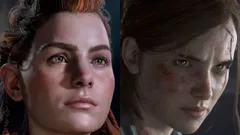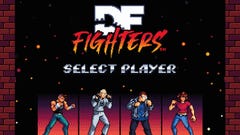DF Weekly: How plausible is the Switch 2 Matrix Awakens demo report?
Switch 2 could be a tech powerhouse - but expectation management is required.
With both Eurogamer and Video Games Chronicle discussing the behind-the-scenes demos of Switch at Gamescom last month, it's important to put what was revealed into context.
The new hardware will deliver a proper generational leap over the Tegra X1-powered hybrid, while the use of a more modern Nvidia architecture opens the door to a wealth of exciting opportunities. However, even if the stories concerning The Matrix Awakens running on target spec hardware with DLSS and ray tracing are true, that doesn't automatically mean we're getting a handheld with the ballpark performance on an Xbox Series S. As always with console hardware - especially Nintendo console hardware - Expectations need to be managed.
It's a topic we discuss in depth on this week's episode of DF Direct Weekly, embedded below for your viewing delight. Every time a new piece of gaming hardware comes along, the actual information we have to begin with via leaks is strikingly limited - and PS5 Pro is another striking example. Everything else sits within the LIZ, a term often used by UFO debunker and ex-Neversoft developer, Mick West. That's the Low Information Zone, and where there is a lack of hard facts, interpretation and wish-fulfilment often step in to bring us to often incorrect conclusions.
- 0:00:00 Introduction
- 0:00:42 News 01: Next-gen Switch demoed with BOTW, Matrix Awakens
- 0:23:30 News 02: Daytona USA 2 re-release incoming!
- 0:32:51 News 03: Paid, DRM-laden DLSS 3 Starfield mod cracked
- 0:40:40 News 04: Jedi: Survivor patch improves performance mode
- 0:52:19 News 05: AMD releases RX 7700 XT, RX 7800 XT GPUs
- 1:14:20 News 06: Interviewer asks: why didn’t Todd Howard optimize Starfield on PC?
- 1:21:58 Supporter Q1: Will the Switch successor rely on the same cartridges as Switch 1?
- 1:26:03 Supporter Q2: Will Nintendo do “next-gen” patches for existing Switch games?
- 1:29:38 Supporter Q3: Do you think Nintendo could use a discrete dock-only GPU for the new Switch?
- 1:33:28 Supporter Q4: Why hasn’t Bethesda switched to Id Tech for all their games?
- 1:37:86 Supporter Q5: Have you considered reporting GPU wattage when benchmarking PC games?
- 1:40:29 Supporter Q6: Are corrective lenses the unsung heroes of Digital Foundry?
Let's try a little thought experiment. Let's go back to the time before the original Switch's debut trailer, when next to nothing was known about the machine, apart from its NX codename. What would have happened if there had been leaks suggesting that Doom 2016 was coming to NX? That The Witcher 3 could run on the machine? That the Sniper Elite games were looking nigh-on identical to the PS4 version? Putting aside that none of these games were likely in development in 2016, the fact is that - yes - Switch did indeed deliver titles that had no business operating on a Tegra X1 processor.
Going hands-on with those games when they eventually did appear and speaking to the developers about them, we could understand how these 'impossible ports' came to be, but if they'd appeared as rumours in the LIZ, the perception would be something quite different. The conclusion from many would be that the Switch was far more powerful than our reporting at the time suggested it would be. Many would be seeing this as strong enough evidence to debunk our original story that Nintendo's console would be running on an older Nvidia mobile processor.
Now apply all of this to reports that Switch 2 is running a demo of The Matrix Awakens. The report is likely true, simply by virtue of the fact that Epic Games has one of the biggest and most talented technological 'brain trusts' in the business. And if you think about it, it has to be true because Unreal Engine 5 is so dominant as the engine of choice for current-gen consoles that there has to be a solution for Switch 2 in the works that somehow gets a version of Lumen and Nanite running on the hardware.
But the point is that until we've actually seen the demo and figured out how Epic Games has refactored its existing work to operate on a mobile processor, there's an awful temptation to overstate how potent the hardware will be. After all, the only frame of reference we have for The Matrix Awakens comes from console and PC demos. The reality may be somewhat different, of course, just like how Doom 2016 and The Witcher 3 present on Switch compared to the PS4 versions.
Of course, Switch 2 will have some advantages that the other systems don't have - and a lot of that is down to the Nvidia collaboration. Just like its predecessor, we should expect the new Switch to be a hybrid console, based on Nvidia's Tegra T239 - a custom off-shoot of the T234 used primarily by the automative industry (the various leaks and LinkedIn mentions about the T239 confirm that it does actually exist!). However, it will also be extremely power-limited by typical console standards, meaning performance expectations need to be couched by reality.
The use of technologies like DLSS and more potent ray tracing hardware may give the system a 'leg up' over AMD-based consoles, but I'd venture to say it's not enough to match Series S performance - sheer brute force compute and memory bandwidth is difficult to overcome in the mobile domain. On the flip side, it's eminently believable that The Matrix Awakens could run on a Switch successor, not just because of those architectual advantages, but also because the latest Unreal Engine 5.2 is so much more performant than the version used to build The Matrix Awakens back in the day.
So, The Matrix Awakens on Switch 2 is plausible, but perhaps in the same way that Doom 2016 and The Witcher 3 are plausible when viewed through the lens of what expert programmers can realistically achieve with more resource-constrained hardware.
The Legend of Zelda: Breath of the Wild's mooted tech demo is an altogether different proposition, sounding more like a practical example of how DLSS can be transformational for consoles - but again, context is king and we don't have any. Our understanding is that the demo runs at 60 frames per second with a 4K output target, but with DLSS's various quality levels, the native internal resolution could be anything from 720p upwards (Switch 1 runs at 720p30 in mobile mode, 900p30 docked). I'd say that this isn't so much about the content, nor about potential back-compat enhancements, but more about the technologies available and how impressive they area.
Even so, with multiple sources now confirming that Nintendo is demonstrating the hardware to developers, there's cause to be excited - even if, right now, we have more questions than answers.









